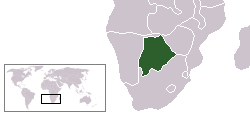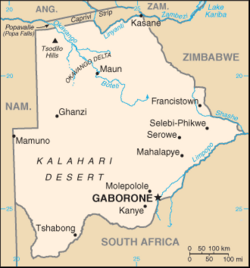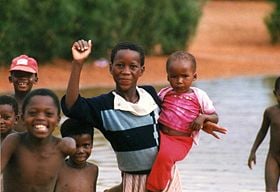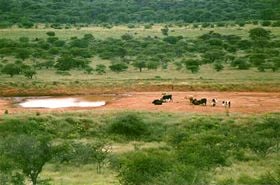Botswana
| Lefatshe la Botswana Republic of Botswana |
||||||
|---|---|---|---|---|---|---|
|
||||||
| Motto: Pula (Rain) | ||||||
| Anthem: Fatshe leno la rona (Blessed Be This Noble Land) |
||||||
| Capital (and largest city) | Gaborone 25°40′S 25°55′E | |||||
| Official languages | English (Official), Tswana (National) | |||||
| Government | Parliamentary republic | |||||
| - | President | Ian Khama | ||||
| - | Vice President | Mompati Merafhe | ||||
| Independence | ||||||
| - | from the United Kingdom | 30 September 1966 | ||||
| Area | ||||||
| - | Total | 581,730 km² (47th) 224,610 sq mi |
||||
| - | Water (%) | 2.6 | ||||
| Population | ||||||
| - | 2010 estimate | 2,029,307 (144th) | ||||
| - | 2001 census | 1,680,863 | ||||
| - | Density | 3.4/km² (229th) 8.9/sq mi |
||||
| GDP (PPP) | 2010 estimate | |||||
| - | Total | $28.491 billion | ||||
| - | Per capita | $15,489 | ||||
| GDP (nominal) | 2010 estimate | |||||
| - | Total | $14.030 billion | ||||
| - | Per capita | $7,627 | ||||
| Gini (1993) | 63 (high) | |||||
| Currency | Pula (BWP) |
|||||
| Time zone | Central Africa Time (UTC+02) | |||||
| Internet TLD | .bw | |||||
| Calling code | [[++267]] | |||||
Botswana, officially the Republic of Botswana, is a landlocked nation in Southern Africa that is considered one of the most stable economically and politically on the continent. The economy, closely tied to South Africa's, is dominated by mining (especially diamonds), cattle, and tourism. Nevertheless, Botswana has been hit very hard by the HIV/AIDS epidemic; the average life expectancy is thirty-four, the worst in the world, and Botswana has the second highest infection rate in the world, after Swaziland. [2] Poverty and high unemployment are other obstacles that need to be overcome if Botswana is to emerge victorious as a nation. The government is trying to diversify its economy to reduce its dependence on the diamond trade while it promotes abstinence and distributes condoms and anti-retroviral drugs to stem the epidemic.
History
The original inhabitants of southern Africa were the Bushmen (San) and Khoe peoples. Both speak click languages and lived as hunters-gatherers. About a thousand years ago, large chiefdoms emerged that were later eclipsed by the Great Zimbabwe Empire, which spread into eastern Botswana. Around 1300 C.E., peoples in present-day Transvaal began to coalesce into three main linguistic and political groups, including the Batswana.
The Batswana (plural of "Motswana"), a term also used to denote all citizens of Botswana, remain the country's major ethnic group today. Prior to European contact, the Batswana lived as herders and farmers under tribal rule. As groups broke off and moved to new land, new tribes were created.
Contacts with Europeans
During the 1700s, the slave and ivory trades were expanding. To resist these pressures, the national leader, King Shaka, formed the Zulu chiefdom. The conquered tribes began to move northwest into Botswana, destroying everything in their path. In their efforts to re-establish themselves at the end of this period, tribes began to exchange ivory and skins for guns with European traders, who had begun to reach the interior. Missionaries sent from Europe also spread to the interior, often at the invitation of chiefs who wanted guns and knew that the presence of missionaries encouraged traders. By 1880 every major village had a resident missionary, and their influence became permanent. Under the reign of king Khama III (reigned 1875–1923), Christianity prevailed, and he is considered one of the most significant converts. Currently more than 70 percent of the population consider themselves to be Christian.
In the late nineteenth century, hostilities broke out between the inhabitants of Botswana and tribes migrating into the territory from the Kalahari Desert. Tensions also escalated with the Boer settlers (Dutch) from the Transvaal. After appeals by the Batswana leaders for assistance, the British government in 1885 put "Bechuanaland" under its protection. The northern territory remained under direct administration as the Bechuanaland Protectorate and is today's Botswana, while the southern territory became part of the Cape Colony and is now part of the northwest province of South Africa.
When the Union of South Africa was formed in 1910 out of the main British colonies in the region, the Bechuanaland Protectorate, Basutoland (now Lesotho), and Swaziland were not included, but provision was made for their later incorporation. However, a vague undertaking was given to consult their inhabitants, and although successive South African governments sought to have the territories transferred, Britain kept delaying, and it never occurred. The election of the National Party government in 1948, which instituted apartheid, and South Africa's withdrawal from the Commonwealth in 1961, ended any prospect of incorporation of the territories into South Africa.
Route to independence
An expansion of British central authority and the evolution of tribal government resulted in the 1920 establishment of two advisory councils representing Africans and Europeans. Proclamations in 1934 regularized tribal rule and powers. A European-African advisory council was formed in 1951, and the 1961 constitution established a consultative legislative council.
In June 1964, Britain accepted proposals for democratic self-government in Botswana. The seat of government was moved from Mafikeng in South Africa to newly established Gaborone in 1965. The 1965 constitution led to the first general elections and to independence on September 30, 1966. Seretse Khama, a leader in the independence movement and the legitimate claimant to the Ngwato chiefship, was elected as the first president, re-elected twice, and died in office in 1980. The presidency passed to the sitting vice president, Quett Masire, who was elected in his own right in 1984 and re-elected in 1989 and 1994. Masire retired from office in 1998. The presidency passed to the vice president, Festus Mogae, who was elected in his own right in 1999 and re-elected by a landslide in 2004. He has said he will step down in 2008 before the next parliamentary election, scheduled for 2009.
Geography
Botswana is bordered by South Africa to the south, Namibia to the west, Zambia to the north, and Zimbabwe to the northeast. It is dominated by the Kalahari Desert, which covers up to 70 percent of the land surface. The Okavango Delta, the world's largest inland delta, is in the northwest. The Makgadikgadi Pan, a large salt pan, lies in the north. Botswana has diverse areas of wildlife habitat, including the Okavango Delta, the Kalahari Desert, grasslands, and savannas. The climate is mostly subtropical.
Politics
Botswana is a representative democratic republic where the president is elected by the National Assembly. Although it is a multi-party state, since independence the party system has been dominated by the Botswana Democratic Party. The government controls the state-owned radio and television broadcasters and limits opposition acess. In addition, the opposition parties disagree among themselves about the tactics and candidates to challenge the ruling party.
The chiefs of the eight largest tribes and seven sub-chiefs serve in a House of Chiefs, which advises the government on tribal affairs.
The judiciary is independent of the executive and the legislature.
Botswana is divided into 9 districts and 28 sub-districts.
Economy
Since independence, Botswana has had the fastest growth in per capita income in the world, though that is now slowing. The government has maintained a sound fiscal policy and a negligible level of foreign debt. It earned the highest sovereign credit rating in Africa and has stockpiled foreign exchange reserves. Botswana's impressive economic record has been built on the foundation of using revenue generated from diamond mining to fuel economic development through prudent fiscal policies and a cautious foreign policy. Debswana, the only diamond mining company operating in Botswana, is 50 percent owned by the government and generates about half of all government revenues. The government is trying to start processing plants for its own gems. The country is also a major beef exporter, since much of the land is too dry for any other use than raising livestock. However, an irrigation system has been initiated by the government to encourage farmers to raise commercial crops. Most of the workforce is engaged in agriculture. Mining jobs account for less than four percent, and the unemployment rate is about 24 percent, though unofficial estimates place it as high as 40 percent.
Over 17 percent of the country's land area has been allocated as national parks and game reserves. Their abundant wildlife is a top draw for tourists, another source of revenue.
Economic development spending is being cut, however, as a result of budget deficits and rising expenditure on health care services. The government recognizes that HIV/AIDS will affect the economy and is trying to combat the epidemic, including free anti-retroviral drug treatment and a nation-wide Prevention of Mother-to-Child Transmission program.
Some of Botswana's budget deficits can be traced to relatively high military expenditures, which some critics contend are unnecessary given the low likelihood of international conflict (though the Botswana government also makes use of these troops for multilateral operations and assistance efforts).
Foreign investment
Botswana seeks to further diversify its economy away from minerals, which account for a third of GDP, down from nearly half of GDP in the early 1990s. Foreign investment and management are welcomed in Botswana. Botswana abolished foreign exchange controls in 1999, has a low corporate tax rate (15 percent), no prohibitions on foreign ownership of companies, and a moderate inflation rate. The World Economic Forum rates Botswana as one of the two most economically competitive nations in Africa.
With its proven record of good economic governance, Botswana was ranked as Africa's least corrupt country by Transparency International in 2004. Botswana is ranked as by far the best credit risk in Africa. Despite continued challenges such as small market size, landlocked location, and cumbersome bureaucratic processes, Botswana remains one of the best investment opportunities in the developing world.
There is increasing investment from China, which has already built hospitals, schools, and roads and is a potential investor in the tourism industry.
Trade organizations
Because of its history and geography, Botswana has long had deep ties to the economy of South Africa. The Southern Africa Customs Union (SACU), comprising Botswana, Lesotho, Swaziland, and South Africa, dates from 1910 and is the world’s oldest customs union. Namibia joined in 1990. Under this arrangement, South Africa has collected levies from customs, sales, and excise duties for all five members, sharing out proceeds based on each country's portion of imports. The exact formula for sharing revenues and the decision-making authority over duties — held exclusively by the government of South Africa — became increasingly controversial, and the members renegotiated the arrangement in 2001. The new structure has now been formally ratified and a SACU Secretariat has been established in Windhoek, Namibia. Following South Africa's accession to the World Trade Organization (WTO), Botswana also joined; many of the SACU duties are thus declining, making products from outside the area more competitive in Botswana. Currently the SACU countries and the United States are negotiating a free trade agreement. Botswana is currently also negotiating a free-trade agreement with Mercosur and an Economic Partnership Agreement with the European Union as part of SADC.
Gaborone is host to the headquarters of the fourteen-nation Southern African Development Community (SADC), a successor to the Southern African Development Coordination Conference (launched in 1980), which focused its efforts on freeing regional economic development from dependence on apartheid South Africa. SADC embraced the newly democratic South Africa as a member in 1994 and has a broad mandate to encourage growth, development, and economic integration in Southern Africa. SADC's Trade Protocol, which was launched on September 1, 2000, calls for the elimination of all tariff and non-tariff barriers to trade by 2008 among the 11 signatory countries. If successful, it will give Botswana companies free access to the far larger regional market. SADC's failure to distance itself from the Mugabe government in Zimbabwe has diminished the number of opportunities for cooperation between the U.S. and SADC.
Foreign relations
Botswana puts a premium on economic and political integration in Southern Africa. It seeks to make SADC a working vehicle for economic development, and promotes efforts to make the region self-policing in terms of preventative diplomacy, conflict resolution, and good governance. It has welcomed post-apartheid South Africa as a partner in these efforts. Botswana joins the African consensus on most major international matters and is a member of international organizations such as the United Nations, the Commonwealth of Nations, and the African Union.
Botswana has taken in economic and political refugees from Zimbabwe, and tension exists in border areas where the newcomers compete for scarce jobs. Another source of friction is Namibia's desire to pump water from the Okavango River, which would divert it from the delta whose wildlife is a main tourist attraction for Botswana.
Demographics
With nearly 40 percent of sexually active adults infected with HIV, UNICEF reported that more than 112,000 children have been orphaned, mostly due to the spread of the disease, and that figure is expected to double or triple by 2010. Though receiving government support once they are registered, those orphaned often are exploited by relatives or have to drop out of school to care for the sick. The government vigorously campaigns against the disease, providing tests, drugs, and condoms, but the virus continues to spread. Life expectancy has dropped to 34.
The government provided access to primary and secondary education free of tuition and, for the poor, uniforms, books, and fees. Education was not compulsory. Approximately 88 percent of children attended school, and 30 percent completed secondary school. Girls and boys attended school at similar rates. School attendance and completion rates were highest in urban areas, where transportation was readily available, and lowest in rural areas, where children lived far from schools and often assisted their families as cattle tenders, domestic laborers, and child care providers.
Children had access to government health care centers, and students in remote areas received two free meals a day at school. Approximately 28 percent of babies born from HIV positive mothers were protected from the virus, largely as a result of the government's Prevention of Mother to Child Transmission Program.
Sexual abuse of students by teachers was a problem, and there were frequent media reports of rape, sexual assault, incest, and defilement. The increasing number of HIV/AIDS orphans contributed to an increase in incest. The law considers incest a punishable act only if it occurs between blood relatives, leaving children unprotected from incestuous acts performed by step parents, caregivers, and the extended family. In view of the belief held by some persons in southern Africa that intercourse with a virgin was a cure for HIV/AIDS, intergenerational sex (sexual relations between older men and girls) and the problems of teenage pregnancy caused by older men received extensive media attention.
Culture
Botswana is the setting for the popular mystery series written by Alexander McCall-Smith, The No. 1 Ladies' Detective Agency, and was also the location for the 1980 movie The Gods Must Be Crazy, which featured the Bushmen, who make up about three percent of the population.
Most of the Bushmen, or San, have been resettled by the Botswana government in an effort, the government says, to protect the wildlife of the Central Kalahari Game Reserve and provide services to the people. The San sued, claiming they had been deprived of the right to live and hunt in their ancestral homeland, and in 2006 the High Court agreed, saying that the Bushmen were "forcibly and wrongly deprived of their possessions."
At the Tsodilo Hills site in Botswana there is one of the highest concentrations of rock art in the world, classified as a World Heritage site by UNESCO. Researchers from Oslo discovered evidence of worship of the python in a cave possibly 40,000 years ago, lending new information about the legendary creation myths of the python being a sacred animal to the early inhabitants of the Kalahari Desert. [1]
Notes
ReferencesISBN links support NWE through referral fees
- "High court gives Bushmen back their land." Washington Times (December 14, 2006).
- "Background Note" and "Human Rights Report" [3], U.S. State Department Retrieved April 28, 2020.
- Charles H. Cutter. Africa 2006. Stryker-Post Publications, Harpers Ferry, WV, 2006. ISBN 1887985727
- Harry A. Gailey, Jr. History of Africa: From earliest times to 1800. Malabar, FL: Krieger Publishing Company, 1999. ISBN 1575241188
External links
All links retrieved November 20, 2023.
- '"Country Profile: Botswana", British Broadcasting Company News.
- University of Pennsylvania - African Studies Center: Botswana
- Botswana Tourism Official website.
Credits
New World Encyclopedia writers and editors rewrote and completed the Wikipedia article in accordance with New World Encyclopedia standards. This article abides by terms of the Creative Commons CC-by-sa 3.0 License (CC-by-sa), which may be used and disseminated with proper attribution. Credit is due under the terms of this license that can reference both the New World Encyclopedia contributors and the selfless volunteer contributors of the Wikimedia Foundation. To cite this article click here for a list of acceptable citing formats.The history of earlier contributions by wikipedians is accessible to researchers here:
The history of this article since it was imported to New World Encyclopedia:
Note: Some restrictions may apply to use of individual images which are separately licensed.





